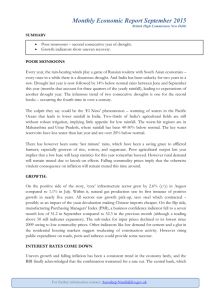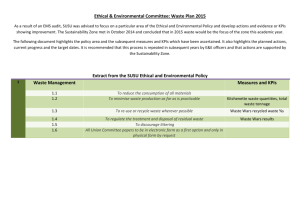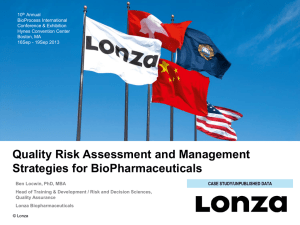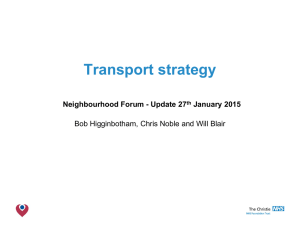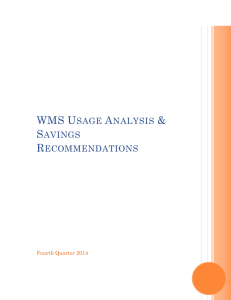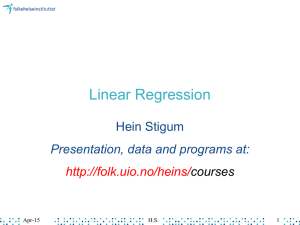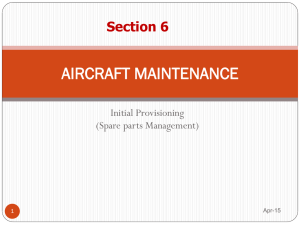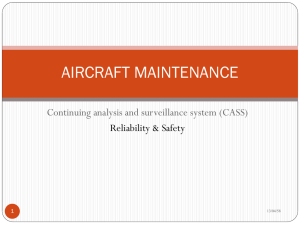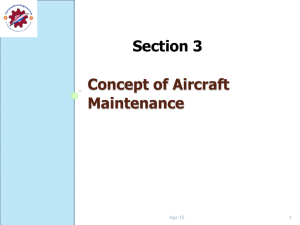Monthly - Toby Tatum
advertisement
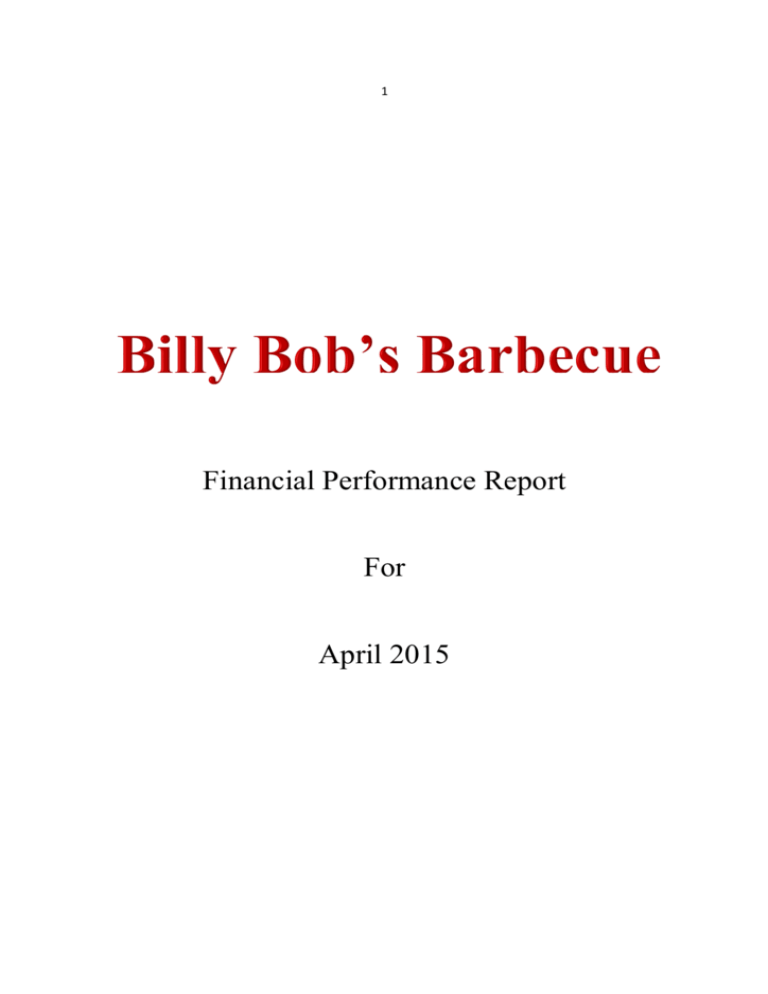
1 Financial Performance Report For April 2015 2 3 TABLE OF CONTENTS User’s Guide on How to Interpret These Analyses Original Income Statement Format Balance Sheet Revised Income Statement Format SALES REVENUE 5 19 20 21 Rolling 12 Month Sale Revenue Review 12 Future Months’ Sales Revenue Projection 23 24 ROLLING 12 MONTH OPERATING COSTS REVIEW & ANALYSES Cost of Goods Sold Direct Labor Cost Marketing Expense Other Variable Costs Total Variable Costs Contribution Margin Sales Revenue & Contribution Margin Non-Discretionary Fixed Costs Discretionary Fixed Costs Operating Costs Volatility Analysis 25 26 27 28 29 30 31 32 33 34 PROFITABILITY ANALYSES Rolling 12 Month Profit Before Discretionary Fixed Costs 12 Month Profit Before Disc. Fixed Costs & 12 Month Projection Rolling 12 Month Pre-Tax Net Profit 12 Month Rolling Pre-Tax Net Profit & 12 Month Projection Rolling 12 Month Contribution Margin minus Total Fixed Costs 12 Future Months Contribution Margin minus Total Fixed Costs Projection Rolling 12 Month Contribution Margin minus Non-Discretionary Fixed Costs 12 Months Contribution Margin minus Non-Dis. Fixed Costs Projection Rolling 12 Month Owner’s Discretionary Cash Flow 12 Month Owner’s Discretionary Cash Flow Projection 35 36 37 38 39 40 41 42 43 44 CASH FLOW ANALYSIS Change in Cash This Month Rolling 12 Months Monthly Change in Cash Balance Rolling 12 Month Cumulative Change in Cash Balance 12 Future Months Change in Cash Balance Projection Rolling 12 Month Cumulative Change in Cash Due To Net Profit Net Working Capital Long-Term Debt Net Asset Value 45 46 47 48 49 50 51 52 4 BALANCE SHEET ANALYSES Working Capital’s Percent of Sales Revenue Inventory Turns Per Month 53 54 CAPSTONE ANALYSES Breakeven Excluding Discretionary Fixed Costs Breakeven Including Discretionary Fixed Costs Industry Averages Benchmark Analyses The Company’s Altman Z Score Calculation The Company’s Most Probable Selling Price 55 56 56 57 58 5 HOW TO INTERPRET THE ANALYSES This financial performance report is an ideal tool to enable business owners and their employees to practice management by exception. Management By Exception (MBE) is a style of management that consists of focus and analysis of statistically relevant anomalies in system performance data. In a reasonably well run company most of the reported data will not reflect any statistically relevant anomalies most of the time. In these cases, a quick glance at a particular system or operation’s historical performance data over a reasonably relevant look-back time period is all that is required. This “quick glance and pass” management technique therewith frees up a great deal of time that management can then devote to those situations that are anomalous in some way. For example, if all operating costs are within a statistically expected or pre-defined acceptable range for the look-back period except one particular cost center which is not performing within acceptable statistical parameters, only that operating cost requires further investigation and discovery of the root cause of unacceptable performance. Management by exception is intended to reduce the managerial load and enable managers to spend their time more effectively in areas where it will have the most impact. This report’s initial presentations are the company’s month end Income Statement and Balance Sheet as prepared by the company’s bookkeeper. Following these financial statements, a reformatted Income Statement is presented. This reformatted Income Statement makes possible a large number of analyses that are not possible to produce using the company’s standard Income Statement format. Indeed, with some bookkeeping software, most notably Quick Books, it is not possible to create the Income Statement format that forms the basis for most of the financial performance analyses presented in this report. The first Income Statement analysis is the company’s rolling 12 months sales revenue history ending with the most recent month’ sales, in this example April, as presented in Figure 1 6 Figure 1 Sales Revenue $90,000.00 $85,000.00 $80,195.30 $80,000.00 $75,000.00 $74,589.37 $75,738.30 $79,017.10 $75,074.30 $74,238.04 $74,049.37 $70,000.00 $72,729.76 $69,736.21 $71,357.95 $68,224.10 $65,000.00 $63,496.19 $60,000.00 $55,000.00 $50,000.00 May-14 Jun-14 Jul-14 Aug-14 Sep-14 Oct-14 Nov-14 Dec-14 Highest Value Lowest Value Average Value High-Low Spread 12 Month Growth Rate Jan-15 Feb-15 Mar-15 Apr-15 $80,195 $63,496 $73,204 $6,991 5.94% Next, this same historical data is re-presented together with a projection line extending 12 months into the future as we see in Figure 2. Figure 2 Sales Revenue with 12 Month Projection $90,000.00 $85,000.00 $80,000.00 $80,195.30 $75,000.00 $74,589.37 $75,738.30 y = -526.93x + 76629 $79,017.10 $75,074.30 $74,238.04 $74,049.37 $72,729.76 $71,357.95 $70,000.00 $69,736.21 $68,224.10 $65,000.00 $63,496.19 $60,000.00 $55,000.00 $50,000.00 1 2 3 4 5 6 7 8 9 10 11 12 13 14 12 Month Projection May-15 $69,779 Jun-15 $69,252 Jul-15 $68,725 Aug-15 $68,198 Sep-15 $67,671 Oct-15 $67,144 Nov-15 $66,617 Dec-15 $66,090 Jan-16 $65,563 Feb-16 $65,037 Mar-16 $64,510 Apr-16 $63,983 15 16 17 18 19 20 21 22 23 24 7 The presentation of a rolling 12 month history is repeated for all of the company’s operating cost centers and earnings categories. There are two reasons for presenting the most recent month end financial performance within the context a rolling 12 month history. The first reason is that the business owner can gain a far better understanding of his or her company’s financial performance for the month just ended when consider within the context of the last 12 months— especially when presented graphically. The second reason is that 12 months’ of data serves well as the basis for projecting the subject performance metric 12 months into the future. It’s true that a simple linear projection line into the future based on the past 12 months’ history is not a very sophisticated forecasting methodology. On the other hand, however, these projections are far better than having little or no idea of what the future may hold in store—especially if current trends suggest trouble ahead if remedial action is not initiated immediately. The best way to get a good feel for “current trends” is to consider the most recent performance data as presented in Figure 2. It would be easy, and probably most likely that without looking at April’s sales as presented in Figure 2 that the business owner would form the opinion that all is well and indeed given April’s sales, believe wholeheartedly that a bright future lies ahead. Well, maybe it does but our trend line is telling us that the jury is still out on this matter. Figure 3 Cost of Goods Sold 53.00% 51.00% 49.00% 47.46% 47.00% 47.09% 45.70% 45.00% 43.00% 42.12% 45.46% 45.62% 43.78% 42.86% 41.21% 41.00% 41.86% 41.48% 39.72% 39.00% 37.00% 35.00% May-14 Jun-14 Jul-14 Aug-14 Sep-14 Coefficient of Variation Highest Value Lowest Value Average Value High-Low Spread 12 Month Growth Rate Oct-14 Nov-14 Dec-14 Jan-15 Feb-15 Mar-15 Apr-15 0.055 47.46% 39.72% 43.70% 7.75% 11.80% Figure 3 presents our first operating cost category to consider. There is a lot to be gleaned from this chart. In this example we’re looking at a chart based on the past twelve months’ Cost of Goods Sold percentage of Sales Revenue. Thus the first thing we see is that the cost of goods sold is presented in terms of its percentage of sales revenue. This is because the Cost of Goods Sold is a variable cost meaning that it varies approximately in tandem or approximately mirrors Sales Revenue’s increases and decreases from month to month. For this reason, assessing the characteristics of any variable cost in terms of that cost’s percentage of sales revenue is by far the most effective way to determine if it is under control and at an acceptable level. 8 Each month’s cost of goods sold’s percentage appears as a dot on the graph. The next feature of this graph to consider are the blue lines connecting the dots. They form something of a zig-zag pattern, the meaning of which will be explained momentarily. The level, red line passing through the middle of the array is the twelve-month average value. The dotted line is a linear regression line thought the data which displays the general twelve-month trend in this cost. Next is the amplitude of the zig-zags. The greater their amplitude the less predictable this metric will be on a going-forward basis. Ideally, we want to see a very low amplitude; all amplitude, i.e. all departure from the red line average value should be considered a bad thing that needs to be minimized and controlled as best as possible. A common way to compare the relative amplitude of two or more performance metrics or compare a single metric to a subjectively determined acceptable maximum amplitude is the array’s Coefficient of Variation. This is the array’s standard deviation divided by the array’s average value. The lower the standard deviation, (i.e., the tighter the grouping of an array’s values around the array’s average value) the lower will be the Coefficient of Variation. Here we see that the Coefficient of Variation is .055. It is highlighted in yellow indicating that it exceeds management’s subjectively established acceptable maximum desired level and that it should be watched. If this cell was red it would mean that this cost is not under control from a volatility perspective. The Coefficient of Variation is a metric that enables one to assess the relative degree of volatility compared to all other variable costs. However, this chart also shows the spread between the highest percent of sales and the lowest percent of sales for this cost over the last twelve months. Comparing this cost center’s metric to other cost centers is not a meaningful exercise. However, this metric is ideally suited to establishing goals for minimizing a cost center’s volatility. The three lines above and below the red center line are one, two and three standard deviations away from the average. The relative width of the one, two and three standard deviations provides management with very good direction as to where to focus their time and energy in system improvement efforts and that is, discerning this cost’s statistical stability. Statistical stability is the absence of any kind of pattern to the zig-zags over the twelve-month history. The absence of any kind of pattern is an indication that the observed oscillations are due entirely to random influences as opposed to influences traceable to a specific, identifiable cause. This does not mean that the performance metric is acceptable; only that it is under control. In our Cost of Goods Sold chart, no patterns are evident which means that this cost is statistically stable. Being statistically stable means that the observed oscillations in the cost’s percentage of sales revenue from month to month are caused by random influences which are often beyond management’s ability to measure or even know their cause. Thus in Figure 3 we see an operating cost that is statistically stable but with an unacceptably wide range in the amplitude of the oscillations and that it is also noticeably higher than its industry’s average value; a comparison we will examine later. There is an extremely important concept that attaches to the indication that a performance metric is statistically stable. That concept is that it is impossible to improve a performance metric that is statistically unstable. In other words, the first order of business in trying to bring about improvement in any phenomena’s performance is to establish that performance’s statistical 9 stability. This is because it is impossible to know if efforts to improve an unstable performance metric are working because its pre-existing instability corrupts measurements of the degree of improvement, if any, that is being attempted. The preceding raises the question of what constitutes a “pattern” in a metric’s observed performance variability over a given time period—in this case twelve months. Well, here is a list: 1. More than 9 consecutive points either above or below the average value. 2. More than 8 consecutive points above or below the average value but all within one or between two and three standard deviations. 3. More than one point greater than two standard deviations either above or below the average. 4. More than 6 points in succession with each value greater than or less than the preceding point (i.e., an upward or downward trend) 5. More than 7 consecutive points above, then below, then above, then below the average value. Another important concept that can be gleaned from our Statistical Control Chart is evidence that attempts to improve a metric’s performance is working. And that evidence is the occurrence of an out-of-control indication. For example, if management embarked on an attempt to reduce the Cost of Goods Sold, proof of that effort’s success would be an “out of control” indication of more than 5 consecutive points below the average value and/or more than 4 points in succession with each value less than the preceding value. In the table below the chart, the bottom metric is the percentage growth rate between the first and twelfth month. This is a number to watch because if it suddenly jumps up from the prior month’s report, that’s a call for investigation and possible action. Also, it is possible for this growth rate metric to show an increase while the 12-month projection line is declining and vice versa. This fact is helpful in keeping you from jumping to the wrong conclusion for the better or the worst by only considering the percentage change between the fist and twelfth month and ignoring what the general trend all twelve months combined is indicating. All of our subject company’s variable cost centers—Cost of Goods Sold, Direct Labor Cost, Marketing Expense, and Other Variable Costs are charted like Figure 2. Assessing an operating cost’s volatility and statistical stability only makes sense for variable costs. It is a company’s variable costs that pose the greatest challenge for minimizing volatility and maintaining statistical stability. Fixed costs are different. The term “fixed” means that this cost does not ebb and flow in tandem with sales revenue. Fixed costs do vary over time and most of the variation (but not all) is attributable to reasons other than changes in sales revenue. Probably the most significant factor that causes fixed costs to change is monetary inflation. Therefore, a fixed cost’s percent of sales revenue is a meaningless metric. The best fixed cost we can use to demonstrate this proposition is rent. In our hypothetical restaurant, its monthly rent is $5,500. This is the amount the owner pays every month. Thus there is no volatility in this cost whatsoever and it is perfectly stable. However, if we calculate its’ percent of sales revenue every 10 month and plot those percentages on a graph we will obtain the same zig-zag pattern we get in all of the variable costs graphs. In this case though our observed “cost volatility” is actually a mirror reflection of the volatility in sales revenue. The same principle goes for all fixed costs but with a little “noise” added in from minor month-to-month fluctuations in those costs. The fixed cost measurement metric management should watch most closely is its long-term trend. This same logic applies to all earnings metrics as well. The next section of this monthly report presents several views of the Contribution Margin. I’m certain that this financial performance metric is unfamiliar to most business owners because I have never seen it on a company’s Income Statement. Be that as it may, the Contribution Margin is an enormously useful performance metric to calculate. It shows the firm’s profit resulting from sales revenue minus all variable costs. In other words, this is the money available to “contribute” to covering all fixed costs and net profit. It summarizes the combined effect of increasing and decreasing changes is all of the firm’s variable costs. It is necessary to watch the trend in the Contribution Margin relative to the company’s fixed costs. If the Contribution Margin’s trend line is converging downward on the Fixed Cost’s trend line it means that the company is heading for bankruptcy because profit hits zero when they converge and goes negative when the fixed costs exceed the contribution margin. Another thing to look for is if the fixed cost trend line is heading upward at a steeper slope than the contribution margin’s trend line. Over the long-run, fixed costs always increase because they are driven significantly by inflation. Thus when the fixed cost upward sloped trend line appears to be converging on a less upward sloped contribution margin’s trend line that could mean trouble ahead unless remedial action isn’t taken which may mean it’s time for some product or service price increases. Additionally, the Contribution Margin’s percent of sales revenue provides the basis for calculating a company’s breakeven sales revenue. This topic will be addressed in detail momentarily. Figure 4 Non-Discretionary Fixed Costs Rent Utilities Property & Liability Insurance Bookeeping & Accounting Depreication & Amortization Expense Interest on Bank Loan Total Non-Discretionary Fixed Costs Total Operating Costs Before Discretionary Costs Operating Profit before Discretionary Costs $5,500.00 $1,508.72 $397.03 $250.00 $4,562.10 $378.22 $12,596.07 $72,518.15 $6,498.95 6.96% 1.91% 0.50% 0.32% 5.77% 0.48% 15.94% 91.27% 8.73% Discretionary Fixed Costs Owner's Salary Overhead on Owner's Salary Owner's Health & Life Insurance Owner's Automobile Expenses Travel & Entertainment Dues & Subscriptions Charitable Contributions Total Discretionary Fixed Costs Total Fixed Costs Total Operating Costs Net Operating Income (Loss) $7,000.00 $770.00 $225.00 $138.99 $456.87 $56.70 $500.00 $9,147.56 $21,743.63 $81,665.71 ($2,648.61) 8.86% 0.97% 0.28% 0.18% 0.58% 0.07% 0.63% 10.94% 26.88% 102.21% -2.21% Following several views of the Contribution Margin, this repot presents several charts presenting three key levels of pre-tax profitability. The first level is Operating Profit Before Discretionary Fixed Costs. In order to grasp what this means, consider how the company’s fixed costs are presented in the reformatted Income Statement presented here as Figure 4. 11 This Income Statement formatting protocol is enormously helpful in understanding the company’s true profitability which is its Operating Profit Before Discretionary Fixed Cost. The next section of the statement, Discretionary Fixed Costs are cost over which the owner has total control to spend as reflected on the statement or take out in cash if so desired. It also serves as a clearly identifiable area where it is possible to cut costs in order to avoid bankruptcy should such action become necessary. The second measurement of the company’s profitability is its pre-tax Net Operating Income (loss). This is the metric meant to appear on the company’s income tax return. As such, most business owners strive to keep it as low as possible. Figure 5 12-Month Total Billy Bob's Barbecue Net Pre-Tax Operating Income (Loss) ($8,029.13) Add Back Depreication & Amortization Expense $54,745.20 Interest on Bank Loan $4,796.78 Total Discretionary Fixed Costs $101,262.53 Owner's Discretioary Cash Flow $212,317.35 The third measure of profitability is Owner’s Discretionary Cash Flow. This financial performance metric does not appear on the company’s Income Statement. It is a separately compiled total of non-cash charges, interest payments plus Operating Profit Before Discretionary Fixed Costs. This metric is by far the most common indication of a company’s profitability used by business brokers, business buyers and often business appraisers in determining what a business is worth and its most probable selling price. Figure 6 Monthly Change In Cash $10,000.00 $8,220.64 $8,000.00 $6,000.00 $4,194.10 $4,000.00 $2,000.00 $2,285.13 $0.00 May-14 ($2,000.00) $4,062.79 $4,137.57 $3,781.49 $2,493.93 Jun-14 ($413.65) Jul-14 Aug-14 Sep-14 Oct-14 Nov-14 Dec-14($683.30) Jan-15 Feb-15 Mar-15 ($1,867.76) ($2,849.95) ($4,000.00) The next group of charts focus on the last eleven months’ monthly change in cash and arguably are the most important of the rolling 12 month analyses to consider. As the saying goes, “managing a business is like playing poker: your profitability can ebb and flow but when you run out of cash, you are out of the game.” A unique feature of the cash flow or change in cash charts are the rolling 12 month cumulative change in cash charts which show the company’s cash 12 balance and provide the business owner with insight to the separate factors that are causing increases and decreases to the company’s cash balance. Cumulative Change in Cash $30,000.00 $24,624.43 $25,000.00 $23,941.13 $23,361.00 $22,073.38 $20,842.94 $19,223.43 $20,000.00 $16,780.15 $15,000.00 Figure 7 $12,586.05 $10,505.77 $10,092.12 Jul-14 Aug-14 $10,000.00 $5,000.00 $2,285.13 $0.00 Jun-14 Sep-14 Oct-14 Nov-14 Dec-14 Jan-15 Feb-15 Mar-15 Apr-15 Cumulative change from Net Profit $8,000.00 $5,332.93 $6,000.00 $3,493.78 $4,000.00 $2,000.00 $1,875.20 $4,231.19 $2,475.07 $1,325.05 $503.81 $156.37 $0.00 Jun-14 Jul-14 Aug-14 Sep-14 Oct-14 Nov-14 Dec-14 Jan-15 Feb-15 Mar-15 Apr-15 Figure 8 ($2,000.00) ($4,408.03) ($4,000.00) ($6,559.96) ($6,000.00) ($8,000.00) ($9,208.57) ($10,000.00) y = -33.697x + 1E+06 Cumulative change from Changes in Long Term Debt $0.00 ($1,518.02) Jun-14 ($2,000.00) Jul-14 ($3,036.04) Aug-14 Sep-14 Oct-14 Nov-14 Dec-14 Jan-15 Feb-15 Mar-15 Apr-15 ($4,554.06) ($4,000.00) ($6,072.08) ($6,000.00) Figure 9 ($7,590.10) ($8,000.00) ($9,108.12) ($10,626.13) ($10,000.00) ($12,144.15) ($12,000.00) ($13,662.17) ($14,000.00) ($15,180.19) ($16,698.21) ($16,000.00) ($18,000.00) Cumulative change from Changes in Net Asset Value $60,000.00 $50,183.10 $50,000.00 $45,621.00 $41,058.90 $40,000.00 Figure 10 $36,496.80 $31,934.70 $27,372.60 $30,000.00 $22,810.50 $18,248.40 $20,000.00 $10,000.00 Adding back depreciation expense $13,686.30 $9,124.20 $4,562.10 $0.00 Jun-14 Jul-14 Aug-14 Sep-14 Oct-14 Nov-14 Dec-14 Jan-15 Feb-15 Mar-15 Apr-15 13 Figure 11 The next chart in this presentation is a Breakeven Analysis. The breakeven analysis is a superb financial planning tool for small businesses in particular but any business generally. However this planning tool is only available to business owners who separate their fixed and variable costs on their P&L. Given this separation, the sales revenue at which a company’s profit equals zero—i.e., the breakeven point can be determined by simply dividing its fixed costs by the Contribution Margin’s percentage of sales revenue. Figure 12 Breakeven Before Discretionary Costs Break Even Analysis The light blue cells are for user data input. All remaining cells are protected Break Even Analysis Based On: Billy Bob's Barbecue Sales Revenue Increments on Chart Contribution Margin's % of Sales Revenue Fixed costs Before Discretionary Costs $10,000 <---use larger sales increments for high sales volume businesses 27.94% $7,656 Figure 12 presents the top section of the breakeven chart where Billy Bob’s Barbecue’s Contribution Margin and Fixed Costs Before owner discretionary costs & non-cash charges are linked in from the current month’s P&L. Figure 13 Fixed Costs = Contribution Margin = $7,656 27.94% of sales Break Even Sales = Proof: Sales = Minus variable costs of Fixed Costs Total $27,398 27,398.22 -19,742.47 -7,655.75 0.00 72.1% of sales 14 Figure 13 presents the calculated breakeven sales which in this example is $27,398 along with proof of that calculation. Figure 14 Figure 14 is a graphic presentation of Figure 13. Figure 15 Fixed Costs $7,655.75 Breakeven Before Discretionary Costs Contribution Margin % of Sales per Enter Actual Sales 27.94% $79,406.18 Current Sales Above Break Even = $52,007.96 65.5% Profit BDC $14,532.32 18.3% Figure 15 shows in dollars and in percentage terms how far above breakeven sales what current sales are as well as the current monthly profit before owner discretionary costs and non-cash charges. Figure 16 1 2 3 4 5 Projections Fixed Costs Adjustment for sales increases Fixed Costs Per Contribution Margin % of Sales per Month Month $7,656 27.94% $7,656 27.94% $7,656 27.94% $7,656 27.94% $7,656 27.94% 0.0% of sales Sales Revenue per Month $79,406.18 $84,406.18 $89,406.18 $94,406.18 $99,406.18 Profit BDC Month $14,532.07 $15,929.20 $17,326.32 $18,723.45 $20,120.57 Figure 16 provides the opportunity for management to perform up to five different “what if” analyses. Here we see that the default data entries are the current fixed costs and current contribution margin’s percentage of sales revenue along with different sales volume. The right hand column then shows the profit before owner discretionary costs and non-cash charges will result from the differing sales level. 15 However, the real benefit obtainable from this section comes from varying the fixed costs and the contribution margin’s percentage of sales revenue to reflect contemplated changes in the business model. For example, suppose management wants to know what gross sales must be in order to earn a profit of $20,000 instead of $14,532.07 in the above example. To do this, simply add $20,000 to total fixed costs of $7,656 and divide that $27,656 total by the contribution margin percent—in this case 27.94%. Figure 17 1 Fixed Costs Per Month $27,656 Contribution Margin % of Sales per Month 27.94% Sales Revenue per Month $98,974.68 Profit BDC Month $0.00 Here we see through trial and error different values are entered for sales revenue until we find a number that produces a profit of zero. (Actually this is done via Excel’ Solver utility which will run several thousand trials per second searching for the number that will produce a value of zero in the right hand column). For another example, let’s say management is thinking of expanding the physical size of their store. They are considering enlarging it by 40% and the cost to do that will be $150,000. They plan to finance the entire cost with monthly payments of $3,000 a month for five years. How much must monthly sales increase in order to generate enough additional cash flow to make those payments? Simply divide this monthly payment by the contribution margin percent. In the above example, sales would have to increase by $3,000 divided by .2794 or $10,737.29 a month. As a final demonstration let’s say management has come up with an idea of how to reduce the firm’s cost of goods sold by making some of the products that they are currently buying from a wholesaler. By doing this, they expect their cost of goods sold to decrease from 43.3% to 36.0% and labor to increase by 3% for a net savings of 4.3% of gross sales. However, they will have to purchase some manufacturing machinery which will require monthly payments of $2,000. Figure 18 1 2 Projections Fixed Costs Adjustment for sales increases Fixed Costs Per Contribution Margin % of Sales per Month Month $7,656 27.94% $9,656 32.24% 0.0% of sales Sales Revenue per Month $79,406.18 $79,406.18 Profit BDC Month $14,532.07 $15,946.54 In Figure 18 scenario 1 presents the current fixed costs, contribution margin’s percent of sales revenue and the current revenue of $79,406.18 which yields a profit before owner discretionary costs and non-cash charges of $14,532.07. Scenario 2 presents the modified business model based on the data as described above. And here we see that the contemplated changes will yield additional profit of $1,414.47 given the same sales revenue. 16 Subscribers to this service are always encouraged to submit “what if” scenarios in the format describe above along with their monthly financial statements. We will be happy to enter that data. Figure 19 compares some key operating costs and balance sheet ratios with industry averages. Generally the differences at first glance will not appear to be significant. However apparent small differences can be quite large when measured against the company’s profitability. For example, this company’s Cost of Goods Sold is higher that its industry average by 2.59% and Direct Labor Cost is higher than its industry average by 4.26% for a combined difference of 6.85%. By dividing 6.86% by the Owner’s Discretionary Cash Flow’s ratio of 18.31% the result is 37.41%. Now, multiply the rolling 12 month total discretionary cash flow of $160,804.51 by .3741 which equals $60,156.97. The balance sheet ratios in Figure 19 also provide some insight regarding the company’s efficiency when compared to industry averages. The number of days it takes to turn over the company’s inventory considered by itself doesn’t tell you much. However when compared to the industry average the ratio can tell you a lot. For example, if the subject company’s ratio is higher than the industry average it may suggest that the company runs out of some inventory from time to time and therewith loses sales. On the other hand, a ratio lower than the industry average may suggest that the company is carrying too much inventory which can cause loses due to damage from improper storage, obsolescence, pilferage, etc. Figure 19 Industry Average Benchmarks Key Operating Costs Cost of Goods Sold Direct Labor Advertising Rent Interest Expense Owner's Discretionary Cash Flow Key Balance Sheet Ratios Total Inventory Turn in days Working Capital's % of Sales Revenue Annual Sales Revenue ÷ FMV Fixed Assets Annual Sales Revenue ÷ FMV Total Assets Current Ratio Quick Ratio Equity's % of Capital Structure (based on the FMV of Total Assets) Rolling 12 Mo. Avg 43.66% 22.46% 4.07% 7.51% 0.55% 18.88% Industry Averages 41.07% 18.20% 3.12% 6.97% 1.00% 8.95% 11.66 64.60% 3.26 2.60 3.19 2.62 61.00% 15.99 0.03% 2.99 2.25 1.33 1.18 65.76% The Fair Market Value of Fixed asset and total asset turnover ratios, i.e., sales revenue divided the asset values compared to industry averages may be an indication that the company has too much or too little invested in assets. The significance of this situation is 17 subtle. When it comes to valuing a business, the lower the investment in fixed assets required to produce a given cash flow, the more the company is worth. This is because net cash flow drives a business’s value therefore the lower the amount of cash required for fixed asset replacements through the years, the greater will be net cash flow. The “fair market value of the firm’s and industry average’s fixed operating equipment is estimated by taking the average of the reported original cost and current net book value. Figure 20 Altman Z Score Is the subject company a manufacturer? Y or N Billy Bob's Barbecue Green Zone: Financially sound if greater than Yellow Zone: Time to take serious action Red Zone: Likelihood of bankruptcy if less than N 3.18 2.60 1.10 to 2.60 1.10 Figure 20 presents Billy Bob’s Barbecue’s Altman Z Score of 3.18. A company’s z-score is a mathematical formula developed to predict the probability of a company filing for bankruptcy within the next two years. The most famous of the accounting-ratio-based models is the Altman z-score first published in 1968 and it was developed via advanced statistical analysis techniques. In its initial test, the Altman Z-Score was found to be 72% accurate in predicting bankruptcy two years prior to the event, with a Type II error (false positives) of 6% (Altman, 1968). In a series of subsequent tests covering three different time periods over the next 31 years (up until 1999), the model was found to be approximately 80-90% accurate in predicting bankruptcy one year prior to the event, with a Type II error (classifying the firm as bankrupt when it does not go bankrupt) of approximately 15-20%. 18 Figure 21 Figure 22 Most Probable Selling Price Billy Bob's Barbecue Owner's Discretionary Cash Flow 12 Month Totals $212,317.35 Valuation Rule of Thumb Multiple Full Service Restaurants Low Average High 1 2 3 Most Probable Selling Price Low Average High Current Assets Not Included In Selling Price $212,317.35 $424,634.70 $636,952.06 $69,061.10 Enterprise Value Low Average High Total Liabilities $281,378.45 $493,695.81 $706,013.16 $206,394.42 We now come to the final and very useful bit of information that can be gleaned from our revised financial performance report. In Figure 21, previously Figure 5, we see that the past twelve-month Net Pre-Tax Operating Income (Loss) is a negative $8,029.12. To this amount we add back the non-cash charges for depreciation expense plus the interest expense plus Total Discretionary Fixed Costs. The sum of these add-backs is known as the Owner’s Discretionary Cash Flow. With the value of Owner’s Low $74,984.04 Discretionary Cash Flow in hand Average $287,301.39 we can turn to the Business High $499,618.74 Reference Guide, the foremost authority on business value rules of thumb and get a rule-of-thumb estimate for the company’s most probable selling price. In the 2015 edition we find that the selling prices for full service restaurants are between 1 and 3 times owner’s discretionary cash flow with an average value of 2. Thus we know that the most probable selling price for Billy Bob’s Barbecue assuming it is average in all respects is approximately $424,634. However, this is the midpoint of a fairly wide range which means that to the degree Billy Bob’s Barbecue is above and/or below average along a host of assessment characteristics this baseline most probable selling price can be adjusted up and/or down to reflect the cumulative effect of its various positive and negative attributes. Seller's Net Proceeds From Sale 19 Original Income Statement Format Billy Bob's Barbecue Sales Revenue Food & Beverage Sales Apr-15 $84,548.29 Cost of Goods Sold Food cost Beer & Wine Total Cost of Goods Sold Gross Profit Bookeeping & Accounting Charitable Contributions Cleaning Materials Depreication & Amortization Expense Direct Labor Direct Mail Advertising Dues & Subscriptions Employer's SSN Federal Unemployment Insurance Gain (loss) on sale of equipment Interest on Bank Loan Loss on sale of assets Newspaper Advertising Outside Maintenance Overhead on Owner's Salary Overtime Labor Owner's Automobile Expenses Owner's Health & Life Insurance Owner's Salary Property & Liability Insurance Radio Advertising Rent Repairs Sales Tax Small Wares State Unemployment Insurance Travel & Entertainment Utilities Vacation Pay Worker's Comp Insurance Yellow Pages Total Operating Costs Pre-Tax Income (Loss) $33,022.50 $4,187.91 $37,210.41 $47,337.88 $250.00 $500.00 $452.45 $4,562.10 $14,332.46 $149.87 $56.70 $1,221.60 $114.09 $0.00 $378.22 $0.00 $1,548.38 $543.84 $770.00 $945.27 $138.99 $225.00 $7,000.00 $397.03 $1,422.84 $5,500.00 $383.83 $5,531.20 $226.22 $163.18 $456.87 $1,508.72 $766.65 $401.10 $39.88 $49,986.50 -$2,648.61 20 Billy Bob's Barbecue ASSETS Current Assets Cash Accounts Receivable Inventory Prepaid Expenses Apr-15 $27,223.47 $10,804.25 $12,256.94 $31,033.38 $81,318.04 9.60% 3.81% 4.32% 10.94% 28.67% Total Assets $287,654.86 $48,951.03 $134,334.57 $202,271.32 $283,589.36 101.43% 17.26% 47.37% 71.33% 100.00% LIABILITIES Current Liabilities Accounts Payable Wages Payable Other Payables Total Current Liabilities $21,885.09 $2,916.63 $1,626.55 $26,428.26 7.72% 1.03% 0.57% 9.32% $179,966.16 63.46% Total Long Term Liabilities Total Liabilities $179,966.16 $206,394.42 63.46% 72.78% OWNERS EQUITY Original Investment Retained Earnings Total Owners Equity Total Owners Equity & Liabilities $75,000.00 $2,194.95 $77,194.95 $283,589.36 26.45% 0.77% 27.22% 100.00% Total Current Assets Fixed Assets Machinery & Equipment Office Equipment Accumulated Depreciation Net Fixed Assets Long Term Liabilities Equipment Note to Wells Fargo 21 Revised Income Statement Format Billy Bob's Barbecue Sales Revenue Food & Beverage Sales Sales Tax Total Revenue (net of sales tax) April 2015 April 2015 $84,548.29 $5,531.20 $79,017.10 107.00% 7.00% 100.00% Total Cost of Goods Sold Gross Profit $33,022.50 $4,187.91 $37,210.41 $41,806.69 41.79% 5.30% 47.09% 52.91% Direct Labor Cost Direct Labor Overtime Labor Vacation Pay Employer's SSN State Unemployment Insurance Federal Unemployment Insurance Worker's Comp Insurance Total Direct Labor Cost Total Prime Costs Gross Margin $14,332.46 $945.27 $766.65 $1,221.60 $163.18 $114.09 $401.10 $17,944.35 $55,154.76 $23,862.33 18.14% 1.20% 0.97% 1.55% 0.21% 0.14% 0.51% 22.71% 69.80% 30.20% Marketing Newspaper Advertising Radio Advertising Yellow Pages Direct Mail Advertising Total Marketing Expenses $1,548.38 $1,422.84 $39.88 $149.87 $3,160.97 1.96% 1.80% 0.05% 0.19% 4.00% Other Variable Costs Cleaning Materials Small Wares Outside Maintenance Repairs Total Other Variable Costs Total Variable Costs Contribution Margin $452.45 $226.22 $543.84 $383.83 $1,606.35 $59,922.08 $19,095.01 0.57% 0.29% 0.69% 0.49% 2.03% 75.83% 24.17% Cost of Goods Sold Food cost Beer & Wine 22 Non-Discretionary Fixed Costs Rent Utilities Property & Liability Insurance Bookeeping & Accounting Depreication & Amortization Expense Interest on Bank Loan Total Non-Discretionary Fixed Costs Total Operating Costs Before Discretionary Costs Operating Profit before Discretionary Costs $5,500.00 $1,508.72 $397.03 $250.00 $4,562.10 $378.22 $12,596.07 $72,518.15 $6,498.95 6.96% 1.91% 0.50% 0.32% 5.77% 0.48% 15.94% 91.27% 8.73% Discretionary Fixed Costs Owner's Salary Overhead on Owner's Salary Owner's Health & Life Insurance Owner's Automobile Expenses Travel & Entertainment Dues & Subscriptions Charitable Contributions Total Discretionary Fixed Costs Total Fixed Costs Total Operating Costs Net Operating Income (Loss) $7,000.00 $770.00 $225.00 $138.99 $456.87 $56.70 $500.00 $9,147.56 $21,743.63 $81,665.71 ($2,648.61) 8.86% 0.97% 0.28% 0.18% 0.58% 0.07% 0.63% 10.94% 26.88% 102.21% -2.21% Other Income Gain (loss) on sale of equipment Loss on sale of assets Total Other Income or Expenses Pre-Tax Income (Loss) $0.00 $0.00 $0.00 $0.00 ($2,648.61) 0.00% 0.00% 0.00% -2.21% 23 Sales Revenue $90,000.00 $85,000.00 $80,195.30 $80,000.00 $75,000.00 $74,589.37 $75,738.30 $79,017.10 $75,074.30 $74,238.04 $74,049.37 $70,000.00 $72,729.76 $69,736.21 $71,357.95 $68,224.10 $65,000.00 $63,496.19 $60,000.00 $55,000.00 $50,000.00 May-14 Jun-14 Jul-14 Aug-14 Sep-14 Oct-14 Highest Value Lowest Value Average Value High-Low Spread 12 Month Growth Rate Nov-14 Dec-14 Jan-15 $80,195 $63,496 $73,204 $6,991 5.94% Feb-15 Mar-15 Apr-15 24 Sales Revenue with 12 Month Projection $90,000.00 $85,000.00 $80,000.00 y = -526.93x + 76629 $80,195.30 $79,017.10 $75,738.30 $75,000.00 $75,074.30 $74,589.37 $74,238.04 $74,049.37 $72,729.76 $71,357.95 $70,000.00 $69,736.21 $68,224.10 $65,000.00 $69,778.91 $69,251.98 $68,725.05 $68,198.12 $67,671.19 $67,144.26 $66,617.33 $66,090.40 $65,563.47 $65,036.54 $64,509.61 $63,982.68 $63,496.19 $60,000.00 $55,000.00 $50,000.00 1 2 3 4 5 6 7 8 9 10 11 Apr-15 May-15 Jun-15 Jul-15 Aug-15 Sep-15 Oct-15 Nov-15 Dec-15 Jan-16 Feb-16 Mar-16 Apr-16 12 13 14 $79,017 $69,779 $69,252 $68,725 $68,198 $67,671 $67,144 $66,617 $66,090 $65,563 $65,037 $64,510 $63,983 15 16 17 18 19 20 21 22 23 24 25 Cost of Goods Sold 53.00% 51.00% 49.00% 47.46% 47.00% 47.09% 45.70% 45.00% 43.00% 41.00% 42.12% 45.46% 45.62% 43.78% 42.86% 41.21% 41.86% 41.48% 39.72% 39.00% 37.00% 35.00% May-14 Jun-14 Jul-14 Aug-14 Sep-14 Coefficient of Variation Highest Value Lowest Value Average Value Hi-Low Spread 12-Month growth rate Oct-14 Nov-14 5.53% 47.46% 39.72% 43.70% 7.75% 1.84% Dec-14 Jan-15 Feb-15 Mar-15 Apr-15 26 Total Direct Labor Cost 25.00% 24.50% 24.00% 23.50% 23.25% 23.00% 22.82% 22.50% 22.00% 21.50% 22.51% 22.78% 22.36% 21.80% 23.28% 22.58% 22.20% 22.20% 22.04% 21.27% 21.00% 20.50% 20.00% May-14 Jun-14 Jul-14 Aug-14 Sep-14 Coefficient of Variation Highest Value Lowest Value Average Value Hi-Low Spread 12-Month growth rate Oct-14 Nov-14 2.47% 23.28% 21.27% 22.42% 2.00% 1.84% Dec-14 Jan-15 Feb-15 Mar-15 Apr-15 27 Total Marketing Expense 4.70% 4.50% 4.36% 4.30% 4.27% 4.24% 4.22% 4.30% 4.10% 4.00% 3.91% 3.90% 3.94% 3.92% 4.00% 3.95% 3.84% 3.70% 3.50% May-14 Jun-14 Jul-14 Aug-14 Sep-14 Oct-14 Coefficient of Variation Highest Value Lowest Value Average Value Hi-Low Spread 12-Month growth rate Nov-14 Dec-14 4.32% 4.36% 3.84% 4.08% 0.53% 13.73% Jan-15 Feb-15 Mar-15 Apr-15 28 Total Other Variable Costs 2.50% 2.40% 2.30% 2.10% 2.00% 2.25% 2.21% 2.20% 2.20% 2.16% 2.09% 2.04% 2.03% 2.04% 2.04% 2.04% 2.03% 1.98% 1.90% 1.80% 1.70% May-14 Jun-14 Jul-14 Aug-14 Sep-14 Oct-14 Coefficient of Variation Highest Value Lowest Value Average Value Hi-Low Spread 12-Month growth rate Nov-14 Dec-14 4.03% 2.25% 1.98% 2.09% 0.27% 6.00% Jan-15 Feb-15 Mar-15 Apr-15 29 Total Variable Costs 82.00% 80.00% 78.00% 76.72% 76.00% 75.39% 75.28% 74.00% 72.00% 70.00% 75.33% 72.45% 71.61% 69.79% 69.23% 68.20% 68.00% 74.35% 69.10% 70.06% 66.00% 64.00% 62.00% May-14 Jun-14 Jul-14 Aug-14 Sep-14 Oct-14 Coefficient of Variation Highest Value Lowest Value Average Value Hi-Low Spread 12-Month growth rate Nov-14 Dec-14 3.99% 76.72% 68.20% 72.29% 8.52% 6.52% Jan-15 Feb-15 Mar-15 Apr-15 30 Contribution Margin 38.00% 31.80% 33.00% 30.77% 30.21% 28.39% 30.90% 29.94% 27.55% 28.00% 24.61% 24.72% Jan-15 Feb-15 25.65% 24.67% 23.28% 23.00% 18.00% May-14 Jun-14 Jul-14 Aug-14 Sep-14 Oct-14 Nov-14 Highest Value Lowest Value Average Value Hi-Low Spread 12-Month growth rate Dec-14 31.80% 23.28% 27.71% 8.52% -22.43% Mar-15 Apr-15 31 Sales Revenue & Contribution Margin $90,000.00 $80,000.00 $70,000.00 $60,000.00 $50,000.00 $40,000.00 $30,000.00 $20,000.00 $10,000.00 Dec-14 Jan-15 Feb-15 Mar-15 Apr-15 May-14 $22,531.35 May-14 Jun-14 $21,499.91 Jul-14 $25,501.87 Aug-14 $17,474.71 Sep-14 $20,451.76 Oct-14 $22,782.17 Nov-14 $21,549.56 Dec-14 $21,776.66 Jan-15 $16,788.97 Feb-15 $15,698.71 Mar-15 $18,306.34 Apr-15 $19,095.01 Total Revenue (net of sales tax) $74,589.37 $75,738.30 $80,195.30 $75,074.30 $74,238.04 $74,049.37 $69,736.21 $72,729.76 $68,224.10 $63,496.19 $71,357.95 $79,017.10 Contribution Margin Jun-14 Jul-14 Aug-14 Sep-14 Oct-14 Nov-14 32 Total Non-Discretionary Fixed Costs $13,000.00 $12,900.00 $12,800.00 $12,700.00 $12,600.00 $12,667.25 $12,702.17 $12,607.94 $12,500.00 $12,596.07 $12,562.56 $12,477.47 $12,400.00 $12,362.25 $12,300.00 $12,346.58 $12,374.70 $12,416.42 $12,344.33 $12,265.87 $12,200.00 $12,100.00 $12,000.00 May-14 Jun-14 Jul-14 Aug-14 Sep-14 Oct-14 Highest Value Lowest Value Average Value Hi-Low Spread 12-Month growth rate Nov-14 Dec-14 $12,702.17 $12,265.87 $12,476.97 $436.30 -0.09% Jan-15 Feb-15 Mar-15 Apr-15 33 Total Discretionary Fixed Costs $10,000.00 $9,500.00 $9,147.56 $9,069.59 $8,866.06 $9,000.00 $8,639.65 $8,500.00 $8,174.11 $8,227.93 $8,230.27 Jul-14 Aug-14 $8,184.27 $8,164.55 $8,172.02 $8,194.13 $8,192.39 Nov-14 Dec-14 Jan-15 Feb-15 Mar-15 $8,000.00 $7,500.00 $7,000.00 May-14 Jun-14 Sep-14 Oct-14 Highest Value Lowest Value Average Value Hi-Low Spread 12-Month growth rate $9,147.56 $8,164.55 $8,438.54 $983.01 10.64% Apr-15 34 Volatility Analysis Billy Bob's Barbecue Sales Revenue Food & Beverage Sales Sales Tax Total Revenue (net of sales tax) Apr-15 12 Month Avg Coefficient of Variation 107.00% 107.00% 7.00% 7.00% 100.00% 100.00% Cost of Goods Sold Food cost Beer & Wine Total Cost of Goods Sold Gross Profit 41.79% 5.30% 47.09% 52.91% 38.26% 5.43% 43.70% 56.30% 0.057 0.042 0.053 High 41.79% 5.95% 47.46% Low 34.66% 5.05% 39.72% Spread 7.13% 0.90% 7.75% Direct Labor Cost Direct Labor Overtime Labor Vacation Pay Employer's SSN State Unemployment Insurance Federal Unemployment Insurance Worker's Comp Insurance Total Direct Labor Cost Total Prime Costs Gross Margin 18.14% 1.20% 0.97% 1.55% 0.21% 0.14% 0.51% 22.71% 69.80% 30.20% 17.97% 1.21% 0.90% 1.50% 0.21% 0.14% 0.53% 22.47% 71.83% 28.17% 0.026 0.033 0.048 0.044 0.053 0.035 0.042 0.024 0.037 18.62% 1.26% 0.97% 1.59% 0.24% 0.16% 0.57% 23.28% 76.72% 16.89% 1.12% 0.83% 1.38% 0.20% 0.13% 0.51% 21.27% 68.20% 1.72% 0.15% 0.14% 0.22% 0.05% 0.02% 0.07% 2.00% 8.52% Marketing Newspaper Advertising Radio Advertising Yellow Pages Direct Mail Advertising Total Marketing Expenses 1.96% 1.80% 0.05% 0.19% 4.00% 1.97% 1.85% 0.05% 0.20% 4.08% 0.052 0.035 0.048 0.040 0.041 2.12% 1.99% 0.05% 0.21% 4.36% 1.82% 1.77% 0.05% 0.19% 3.84% 0.30% 0.22% 0.01% 0.02% 0.53% Other Variable Costs Cleaning Materials Small Wares Outside Maintenance Repairs Total Other Variable Costs Total Variable Costs Contribution Margin 0.57% 0.29% 0.69% 0.49% 2.03% 75.83% 24.17% 0.61% 0.28% 0.70% 0.50% 2.09% 72.33% 27.67% 0.054 0.044 0.046 0.043 0.039 0.039 0.66% 0.30% 0.78% 0.54% 2.25% 76.72% 0.57% 0.27% 0.63% 0.46% 1.98% 68.20% 0.09% 0.03% 0.15% 0.08% 0.27% 8.52% 35 Operating Profit Before Discretionary Fixed Costs $18,000.00 $16,000.00 $14,000.00 $12,834.62 $12,000.00 $10,000.00 $9,923.41 $10,219.62 $9,202.98 $9,022.44 $8,089.50 $8,000.00 $8,901.96 $6,000.00 $6,040.46 $4,772.54 $4,000.00 $6,498.95 $4,444.64 $3,282.29 $2,000.00 $0.00 May-14 Jun-14 Jul-14 Aug-14 Sep-14 Oct-14 Nov-14 Dec-14 ($2,000.00) Highest Value Lowest Value Average Value Hi-Low Spread 12-Month growth rate $12,834.62 $3,282.29 $7,769.45 $9,552.33 -52.69% Jan-15 Feb-15 Mar-15 Apr-15 36 Operating Profit Before Discretionary Fixed Costs & 12 Month Projection $18,000.00 $16,000.00 $14,000.00 y = -460.11x + 10760 $12,000.00 $10,000.00 $8,000.00 $6,000.00 $4,000.00 $2,000.00 $0.00 1 2 3 4 5 6 7 8 9 10 11 12 13 ($2,000.00) Projection May-15 $4,778.57 Jun-15 $4,318.46 Jul-15 $3,858.35 Aug-15 $3,398.24 Sep-15 $2,938.13 Oct-15 $2,478.02 Nov-15 $2,017.91 Dec-15 $1,557.80 Jan-16 $1,097.69 Feb-16 $637.58 Mar-16 $177.47 Apr-16 ($282.64) 14 15 16 17 18 19 20 21 22 23 24 37 Pre-Tax Net Operating Profit $8,000.00 $6,000.00 $4,606.69 $4,000.00 $2,000.00 $1,749.30 $0.00 May-14 $156.37 Jun-14 Jul-14 $1,150.02 Aug-14 ($550.15)Oct-14 Sep-14 $1,018.71 Nov-14 $737.41 Dec-14 Jan-15 Feb-15 Mar-15 ($2,000.00) ($4,000.00) Apr-15 ($2,151.93) ($2,648.61) ($3,457.73) ($3,727.38) ($4,911.84) ($6,000.00) ($8,000.00) Highest Value Lowest Value Average Value Hi-Low Spread 12-Month growth rate $4,606.69 ($4,911.84) ($669.09) $9,518.53 -166.05% 38 Pre-Tax Net Operating Profit $8,000.00 $6,000.00 y = -466.43x + 2362.7 $4,606.69 $4,000.00 $2,000.00 $1,749.30 $0.00 1 $156.37 2 3 $1,150.02 $1,018.71 $737.41 4 5 ($550.15) 6 7 8 9 10 11 ($2,000.00) ($4,000.00) ($3,457.73) 12 13 14 ($2,151.93) ($2,648.61) ($3,727.38) ($4,911.84) ($6,000.00) ($8,000.00) ($10,000.00) Projection May-15 ($3,700.89) Jun-15 ($4,167.32) Jul-15 ($4,633.75) Aug-15 ($5,100.18) Sep-15 ($5,566.61) Oct-15 ($6,033.04) Nov-15 ($6,499.47) Dec-15 ($6,965.90) Jan-16 ($7,432.33) Feb-16 ($7,898.76) Mar-16 ($8,365.19) Apr-16 ($8,831.62) 15 16 17 18 19 20 21 22 23 24 39 Contribution Margin, Total Fixed Costs and Pre-Tax Profit $30,000.00 $25,000.00 $20,000.00 $20,782.05 $22,531.35 $21,343.53 $20,895.18 $25,501.87 $20,932.44 $21,001.90 $21,632.15 $22,782.17 $21,499.91 $20,451.76 $15,000.00 $20,530.86 $21,039.25 $21,549.56 $21,776.66 $17,474.71 $20,516.35 $16,788.97 $20,610.55 $20,458.26 $21,743.63 $18,306.34 $19,095.01 $15,698.71 $10,000.00 $5,000.00 y = -15.351x + 642955 $0.00 May-14 Jun-14 Jul-14 Aug-14 Sep-14 Oct-14 Nov-14 Dec-14 Jan-15 Feb-15 Mar-15 Apr-15 Jan-15 $16,788.97 Feb-15 $15,698.71 Mar-15 $18,306.34 Apr-15 $19,095.01 ($5,000.00) ($10,000.00) Contribution Margin May-14 $22,531.35 Jun-14 $21,499.91 Jul-14 $25,501.87 Aug-14 $17,474.71 Sep-14 $20,451.76 Oct-14 $22,782.17 Nov-14 $21,549.56 Dec-14 $21,776.66 Total Fixed Costs $20,782.05 $21,343.53 Profit $1,749.30 $156.37 $20,895.18 $20,932.44 $21,001.90 $21,632.15 $20,530.86 $21,039.25 $20,516.35 $20,610.55 $20,458.26 $21,743.63 $4,606.69 ($3,457.73) ($550.15) $1,150.02 $1,018.71 $737.41 ($3,727.38) ($4,911.84) ($2,151.93) ($2,648.61) 40 Contribution Margin, Total Fixed Costs & Pre-Tax Profit with 12 Month Projection $30,000.00 y = -8.5742x + 21013 $25,000.00 $20,000.00 $15,000.00 y = -475x + 23376 $10,000.00 $5,000.00 y = -466.43x + 2362.7 $0.00 1 2 3 4 5 6 7 8 9 10 11 12 13 14 15 16 17 ($5,000.00) ($10,000.00) ($15,000.00) Projections for May-15 Jun-15 Jul-15 Aug-15 Sep-15 Oct-15 Nov-15 Dec-15 Jan-16 Feb-16 Mar-16 Apr-16 Contribution Margin Fixed Costs $17,201 $20,902 $16,726 $20,893 $16,251 $20,884 $15,776 $20,876 $15,301 $20,867 $14,826 $20,859 $14,351 $20,850 $13,876 $20,842 $13,401 $20,833 $12,926 $20,824 $12,451 $20,816 $11,976 $20,807 Profit ($3,701) ($4,167) ($4,633) ($5,100) ($5,566) ($6,033) ($6,499) ($6,966) ($7,432) ($7,898) ($8,365) ($8,831) 18 19 20 21 22 23 24 41 Contribution Margin, Total Non-Discretionary Fixed Costs and Profit $30,000.00 $25,501.87 $25,000.00 $22,531.35 $22,782.17 $21,499.91 $20,451.76 $20,000.00 $15,000.00 $21,549.56 $21,776.66 $17,474.71 $16,788.97 $18,306.34 $19,095.01 $15,698.71 $12,607.94 $12,477.47 $12,667.25 $12,702.17 $12,362.25 $12,562.56 $12,346.58 $12,874.70 $12,344.33 $12,416.42 $12,265.87 $12,596.07 $12,834.62 $10,000.00 $9,923.41 $5,000.00 $10,219.62 $9,022.44 $8,089.50 $9,202.98 $8,901.96 $4,772.54 $4,444.64 $0.00 May-14 Jun-14 Jul-14 Aug-14 Sep-14 Oct-14 Nov-14 Dec-14 Jan-15 $6,040.46 $6,498.95 Mar-15 Apr-15 $3,282.29 Feb-15 Contribution Margin May-14 Jun-14 Jul-14 Aug-14 Sep-14 Oct-14 Nov-14 Dec-14 Jan-15 Feb-15 Mar-15 Apr-15 $22,531.35 $21,499.91 $25,501.87 $17,474.71 $20,451.76 $22,782.17 $21,549.56 $21,776.66 $16,788.97 $15,698.71 $18,306.34 $19,095.01 Total Non-Discretionary Fixed Costs $12,607.94 $12,477.47 $12,667.25 $12,702.17 $12,362.25 $12,562.56 $12,346.58 $12,874.70 $12,344.33 $12,416.42 $12,265.87 $12,596.07 Profit Before Discretionary Fixed Costs $9,923.41 $9,022.44 $12,834.62 $4,772.54 $8,089.50 $10,219.62 $9,202.98 $8,901.96 $4,444.64 $3,282.29 $6,040.46 $6,498.95 42 Contribution Margin, Non-Discretionary Fixed Costs & Profit $30,000.00 $25,000.00 $20,000.00 y = -475x + 23376 $15,000.00 y = -14.89x + 12615 $10,000.00 $5,000.00 y = -460.11x + 10760 $0.00 1 2 3 4 5 6 7 8 9 10 11 12 13 14 15 16 ($5,000.00) Projections for May-15 Jun-15 Jul-15 Aug-15 Sep-15 Oct-15 Nov-15 Dec-15 Jan-16 Feb-16 Mar-16 Apr-16 Contribution Margin Fixed Costs $17,201 $12,421 $16,726 $12,407 $16,251 $12,392 $15,776 $12,377 $15,301 $12,362 $14,826 $12,347 $14,351 $12,332 $13,876 $12,317 $13,401 $12,302 $12,926 $12,287 $12,451 $12,273 $11,976 $12,258 Profit $4,780 $4,319 $3,859 $3,399 $2,939 $2,479 $2,019 $1,559 $1,099 $639 $178 ($282) 17 18 19 20 21 22 23 24 43 Owner's Discretionary Cash Flow $25,000 $20,000 $17,810 $14,907 $15,000 $15,183 $14,002 $13,057 $14,163 $13,858 $9,744 $10,000 $9,396 $10,985 $11,439 Mar-15 Apr-15 $8,230 $5,000 $0 May-14 Jun-14 Jul-14 Aug-14 Sep-14 Highest Value Lowest Value Average Value Hi-Low Spread 12-Month growth rate Oct-14 Nov-14 $17,810.37 $8,230.21 $12,731.28 $9,580.16 -30.32% Dec-14 Jan-15 Feb-15 44 Owner's Discretionary Cash Flow & 12 Month Projection $25,000 y = -464.09x + 15748 $20,000 $15,000 $10,000 $5,000 $0 1 2 3 4 5 6 7 8 9 10 11 12 Apr-15 May-15 Jun-15 Jul-15 Aug-15 Sep-15 Oct-15 Nov-15 Dec-15 Jan-16 Feb-16 Mar-16 Apr-16 13 14 15 16 17 Annualized $11,439 $152,775.38 $9,715 $9,251 $8,787 $8,323 $7,858 $7,394 $6,930 $6,466 $6,002 $5,538 $5,074 $4,610 18 19 20 21 22 23 24 45 Change In Cash Analysis Billy Bob's Barbecue ASSETS Current Assets Mar-15 Column B Apr-15 Column C Cash Accounts Receivable Inventory Prepaid Expenses Total Current Assets $23,085.90 $16,952.01 $18,805.94 $45,646.00 $104,489.85 $27,223.47 $10,804.25 $12,256.94 $31,033.38 $81,318.04 Fixed Assets Machinery & Equipment Office Equipment Accumulated Depreciation Net Fixed Assets Total Assets Jul-87 $48,951.03 -$129,772.47 $206,833.42 $311,323.26 Jul-87 $48,951.03 -$134,334.57 $202,271.32 $283,589.36 LIABILITIES Current Liabilities Accounts Payable Wages Payable Other Payables Total Current Liabilities $35,600.00 $9,826.16 $4,569.36 $49,995.52 $21,885.09 $2,916.63 $1,626.55 $26,428.26 $181,484.18 $179,966.16 Total Long Term Liabilities Total Liabilities $181,484.18 $231,479.70 $179,966.16 $206,394.42 OWNERS EQUITY Original Investment Retained Earnings Total Owners Equity Total Owners Equity & Liabilities $75,000.00 $4,843.56 $79,843.56 $311,323.26 $75,000.00 $2,194.95 $77,194.95 $283,589.36 Long Term Liabilities Equipment Note to Wells Fargo B minus C $6,147.76 $6,549.00 $14,612.62 B minus C $4,562.10 C minus B ($13,714.92) ($6,909.53) ($2,942.81) C minus B ($1,518.02) C minus B $0.00 ($2,648.61) $4,137.58 $4,137.57 46 Rolling Monthly Change In Cash 10000 $8,220.64 8000 6000 4000 $4,194.10 $4,062.79 $3,781.49 Oct-14 Nov-14 Dec-14 $4,137.57 $2,493.93 $2,285.13 2000 -$413.65 0 May-14 -2000 -4000 Jun-14 Jul-14 Aug-14 -$683.30 Sep-14 Jan-15 Feb-15 -$1,867.76 Mar-15 -$2,849.95 Apr-15 47 Cumulative Change in Cash $30,000.00 $24,624.44 $25,000.00 $23,941.14 $23,361.00 $22,073.38 $20,842.94 $19,223.42 $20,000.00 $16,780.16 $15,000.00 $12,586.05 $10,505.77 $10,092.12 Jul-14 Aug-14 $10,000.00 $5,000.00 $2,285.13 $0.00 Jun-14 Sep-14 Oct-14 Nov-14 Dec-14 Jan-15 Feb-15 Mar-15 Apr-15 48 Cumulative Change In Cash & 12 Month Projection $60,000.00 $50,768 $48,889 $47,009 $45,130 $43,250 $41,371 $39,491 $37,612 $35,733 $33,853 $31,974 $30,094 $28,215 $26,335 $50,000.00 $40,000.00 $30,000.00 $24,624.44 $23,941.14 $20,842.94 $20,000.00 $23,361.00 $22,073.38 $19,223.42 $16,780.16 $10,505.77 $10,092.12 $12,586.05 $10,000.00 y = 1879.5x + 5660.6 $2,285.13 $0.00 1 2 3 4 5 6 7 8 9 10 11 12 13 14 15 16 17 18 19 20 21 22 23 24 49 Cumulative change from Net Profit $8,000.00 $5,332.93 $6,000.00 $3,493.78 $4,000.00 $2,000.00 $1,875.20 $4,231.19 $2,475.07 $1,325.05 $503.81 $156.37 $0.00 Jun-14 Jul-14 Aug-14 Sep-14 Oct-14 Nov-14 Dec-14 Jan-15 Feb-15 Mar-15 Apr-15 ($2,000.00) ($4,000.00) ($4,408.03) ($6,559.96) ($6,000.00) ($8,000.00) ($10,000.00) ($9,208.57) y = -33.697x + 1E+06 50 Cumulative change from Changes in Net Working Capital $0.00 ($2,000.00) ($4,000.00) ($6,000.00) ($8,000.00) ($915.32) Jun-14 Jul-14 ($1,830.64) Aug-14 Sep-14 Oct-14 Nov-14 Dec-14 Jan-15 Feb-15 Mar-15 Apr-15 ($2,745.95) ($3,661.27) ($4,576.59) ($5,491.91) ($6,407.22) ($7,322.54) ($8,237.85) ($10,000.00) ($12,000.00) ($12,895.28) ($13,810.59) ($14,000.00) ($16,000.00) 51 Cumulative change from Changes in Long Term Debt $0.00 ($2,000.00) ($4,000.00) ($1,518.02) Jun-14 Jul-14 ($3,036.04) Aug-14 Sep-14 Oct-14 Nov-14 Dec-14 Jan-15 Feb-15 Mar-15 Apr-15 ($4,554.06) ($6,072.08) ($6,000.00) ($8,000.00) ($10,000.00) ($12,000.00) ($14,000.00) ($16,000.00) ($18,000.00) ($7,590.10) ($9,108.12) ($10,626.13) ($12,144.15) ($13,662.17) ($15,180.19) ($16,698.21) 52 Cumulative change from Changes in Net Asset Value $60,000.00 $50,183.10 $50,000.00 $45,621.00 $41,058.90 $40,000.00 $36,496.80 $31,934.70 $27,372.60 $30,000.00 $22,810.50 $18,248.40 $20,000.00 $10,000.00 $13,686.30 $9,124.20 $4,562.10 $0.00 Jun-14 Jul-14 Aug-14 Sep-14 Oct-14 Nov-14 Dec-14 Jan-15 Feb-15 Mar-15 Apr-15 53 Inventory Turms Per Month 3.50 3.04 3.00 2.47 2.50 2.00 2.35 2.27 1.92 1.90 1.92 2.00 1.82 1.81 Oct-14 Nov-14 1.72 1.73 Feb-15 Mar-15 1.50 1.00 0.50 0.00 May-14 Jun-14 Jul-14 Aug-14 Sep-14 Dec-14 Jan-15 Apr-15 54 Working Capital's % of Sales Revenue 120.00% 100.00% 80.00% 75.10% 77.21% Nov-14 Dec-14 81.31% 84.42% 76.37% 69.47% 65.24% 60.00% 52.42% 41.04% 55.44% 59.42% 44.65% 40.00% 20.00% 0.00% May-14 Jun-14 Jul-14 Aug-14 Sep-14 Oct-14 Jan-15 Feb-15 Mar-15 Apr-15 55 Breakeven Before Discretionary Costs Break Even Analysis The light blue cells are for user data input. All remaining cells are protected Break Even Analysis Based On: Billy Bob's Barbecue Sales Revenue Increments on Chart Contribution Margin's % of Sales Revenue Fixed costs Before Discretionary Costs $10,000 <---use larger sales increments for high sales volume businesses 24.17% $4,562 Fixed Costs = Contribution Margin = $4,562 24.17% of sales Break Even Sales = Proof: Sales = Minus variable costs of Fixed Costs Total $18,878 18,878.43 -14,316.33 -4,562.10 0.00 $140,000 75.8% of sales Breakeven Analsis $120,000 $100,000 $80,000 $60,000 $40,000 $20,000 $0 $0 $10,000 $20,000 $30,000 $40,000 $50,000 $60,000 Break Even Analysis Fixed Costs $4,562.10 1 2 3 4 5 $70,000 Fixed Costs $80,000 $90,000 $110,000 Variable Costs Breakeven Before Discretionary Costs Contribution Margin % of Sales per Enter Actual Sales 24.17% $79,017.10 Current Sales Above Break Even = $60,138.67 76.1% Projections Fixed Costs Adjustment for sales increases Fixed Costs Per Contribution Margin % of Sales per Month Month $7,656 24.17% $7,656 24.17% $7,656 24.17% $7,656 24.17% $7,656 24.17% $100,000 0.0% of sales Sales Revenue per Month $79,406.18 $79,406.18 $79,017.00 $84,017.00 $89,017.00 Profit BDC $14,532.91 18.4% Profit BDC Month $11,533.04 $11,533.04 $11,438.99 $12,647.27 $13,855.56 $120,000 56 Breakeven After Discretionary Costs Break Even Analysis The light blue cells are for user data input. All remaining cells are protected Break Even Analysis Based On: Billy Bob's Barbecue Sales Revenue Increments on Chart Contribution Margin's % of Sales Revenue Total Fixed costs $10,000 <---use larger sales increments for high sales volume businesses 24.17% $21,744 Fixed Costs = Contribution Margin = $21,744 24.17% of sales Break Even Sales = Proof: Sales = Minus variable costs of Fixed Costs Total $89,977 89,977.33 -68,233.70 -21,743.63 0.00 $140,000 75.8% of sales Breakeven Analsis $120,000 $100,000 $80,000 $60,000 $40,000 $20,000 $0 $0 $10,000 $20,000 $30,000 $40,000 $50,000 $60,000 Break Even Analysis Fixed Costs $21,743.63 1 2 3 4 5 $70,000 Fixed Costs $80,000 $90,000 $110,000 Variable Costs Breakeven After Discretionary Costs Contribution Margin % of Sales per Enter Actual Sales 24.17% $79,017.10 Current Sales Above Break Even = -$10,960.23 -13.9% Projections Fixed Costs Adjustment for sales increases Fixed Costs Per Contribution Margin % of Sales per Month Month $7,656 24.17% $7,656 24.17% $7,656 24.17% $7,656 24.17% $7,656 24.17% $100,000 0.0% of sales Sales Revenue per Month $79,406.18 $79,406.18 $79,017.00 $84,017.00 $89,017.00 Net Profit -$2,648.61 -3.4% Net Profit Month $11,533.04 $11,533.04 $11,438.99 $12,647.27 $13,855.56 $120,000 57 Industry Average Benchmarks Key Operating Costs Cost of Goods Sold Direct Labor Advertising Rent Interest Expense Owner's Discretionary Cash Flow Key Balance Sheet Ratios Total Inventory Turn in days Working Capital's % of Sales Revenue Annual Sales Revenue ÷ FMV Fixed Assets Annual Sales Revenue ÷ FMV Total Assets Current Ratio Quick Ratio Rolling 12 Mo. Avg 43.66% 22.46% 4.07% 7.51% 0.55% 17.39% Industry Averages 41.07% 18.20% 3.12% 6.97% 1.00% 8.95% 11.66 64.60% 3.26 2.60 3.19 2.62 15.99 0.03% 2.99 2.25 1.33 1.18 Altman Z Score Is the subject company a manufacturer? Y or N Billy Bob's Barbecue Green Zone: Financially sound if greater than Yellow Zone: Time to take serious action Red Zone: Likelihood of bankruptcy if less than N 3.18 2.60 1.10 to 2.60 1.10 58 Most Probable Selling Price Billy Bob's Barbecue Owner's Discretionary Cash Flow 12 Month Totals $212,317.35 Valuation Rule of Thumb Multiple Full Service Restaurants Low Average High 1 2 3 Most Probable Selling Price Low Average High Current Assets Not Included In Selling Price $212,317.35 $424,634.70 $636,952.06 $69,061.10 Enterprise Value Low Average High Total Liabilities $281,378.45 $493,695.81 $706,013.16 $206,394.42 Seller's Net Proceeds From Sale Low Average High $74,984.04 $287,301.39 $499,618.74

